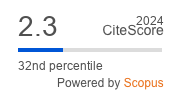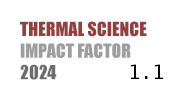THERMAL SCIENCE
International Scientific Journal
Thermal Science - Online First
online first only
Analysis of nitrogen oxides emission reduction and changes in exergy by flue gas recirculation during natural gas combustion
ABSTRACT
With the development of the economy and society in the world, fuel consumption has increased, and thus the emission of pollutants into the environment. Since gaseous fuels represent the most environmentally friendly type of fossil fuel, the emission of nitrogen oxides, as the main pollutant during their combustion, is causing more and more research interest. This paper deals with the impact of recirculation of combustion products on the reduction of nitrogen oxide emissions, and exergy destruction as its consequence. In the first part of the paper, mechanisms of nitrogen oxides formation and the factors that affect it are reviewed. After that, a simplified analysis of the flue gases recirculation was performed especially its influence on emission reduction and exergy losses in flue gases stream. The results are discussed in last part of the paper. Presented results can be very useful for quick emission calculations in process of designing natural gas boiler plants.
KEYWORDS
PAPER SUBMITTED: 2025-12-18
PAPER REVISED: 2025-02-18
PAPER ACCEPTED: 2025-02-21
PUBLISHED ONLINE: 2025-04-05
- Zajacs, A. et al., Impact of Flue Gas Recirculation on the Efficiency of Hot-water Boilers, Construction of Unique Buildings and Structures, 93, (2020), 8, p. 9304
- Al Wahedi, F. S. A. A., Dadach, Z., E., Cost Effective Strategies to Reduce CO2 Emissions in the UAE: A Literature Review Industrial Engineering and Management, 2 (2013), 4, p. 1000116
- Tanasić, N., et al., Effects of Flue Gas Recirculation on NOx Emission from Gas-Fired Utility Boilers, Current Problems in Experimental and Computational Engineering, Proceedings of the International Conference of Experimental and Numerical Investigations and New Technologies, CNNTech 2021, Zlatibor, Serbia, 2021, pp. 319-337
- Yue. T., et al., Emission characteristics of NOx, CO, NH3 and VOCs from gas-fired industrial boilers based on field measurements in Beijing city, China, Atmospheric environment, 184 (2018), pp.1-8
- Nikolić, J., et al., Measures and Methods to reduce Nitrogen Oxide Emissions from Glass Melting Furnaces (in Serbian), Tehnika - rudarstvo, geologija i metalurgija 62 (2011), 3, pp. 393-398
- Gholami, F., et al., Technologies for the nitrogen oxides reduction from flue gas: a review, Science of the Total Environment, 714 (2020), 136712
- Turns, T., An Introduction to Combustion: Concepts and Applications, Third edition, Mc Graw Hill, New York, USA, 2012
- Bowman C, Control of Combustion-generated Nitrogen Oxides Emissions: Technology driven by Regulation, Twenty-Fourth Symposium (International) on Combustion, the Combustion Institute, Sydney, Australia, July 5-10, 1992. Vol. 24, pp. 859-878
- Jerzak, W., Emissions of NOx and CO from Natural Gas Combustion with Adding CO2 at Varying Distances from the burner, Rocznik Ochrona Środowiska, 16 (2014), 1, pp. 148-160
- Navrodska, R., et al., Reducing nitrogen oxide emissions in boilers at moistening of blowing air in heat recovery systems, 11th Conference on Interdisciplinary Problems in Environmental Protection and Engineering EKO-DOK 2019, E3 Web of Conferences, Polanica-Zdrój, Poland, 2019, Vol. 100
- Pan, D., et al., Effects of flue gas recirculation on self-excited combustion instability and NOx emission of a premixed flame, Thermal Science and Engineering Progress, 30 (2022), p. 101252
- ***, Internal data of Faculty of Mechanical Engineering of University of Nis
- Abdelaal, M., et al., Effect of flue gas recirculation on burner performance and emissions, Journal of Al Azhar University Engineering Sector, 11 (2016) 41, pp. 1275-1284
- Varga, A., et al., Influence of Flue Gas Recirculation on NOx and CO Formation, Strojarstvo, 46 (2004), 1-3, pp. 51-55
- Cho, S. H., et al., Impact of flue gas recirculation methods on NO emissions and flame stability in a swirling methane burner, Applied Thermal Engineering, 261 (2025) p. 125139
- Nhan, H. K., et al., CFD investigation of NOx reduction with a flue-gas internal recirculation burner in a mid-sized boiler, Journal of Mechanical Science and Technology, 33 (2019), 6, pp. 2967-2978
- Zajemska, M., et al., The Kinetics of Nitrogen Oxides Formation in the Flame Gas, Economic and Environmental Studies, 15 (2015), 4, pp. 445-460
- ***, CIBSE Journal, www.cibsejournal.com/cpd/modules/2016-12-nox/
- Đurić, V, Parni kotlovi - sveska 1, teorijske osnove, in Serbian (Steam Boilers - Vol 1, Theoretic Fundamentals), Građevinska knjiga, Belgrade, SFR Yugoslavia, 1969
- Cengel, Y., Bolen, M., Thermodynamics: An Engineering approach, eight edition, Mc Graw Hill, New York, USA, 2015
- Smiljanić, M., et al., The problem of loss determination of technical work of exit gases in a boiler stack - contribution to the solution (in Serbian), Termotehnika 42 (2016), 1, pp. 99-111
- Mitić, D., Mihajlović, E., Metode izračunavanja temperature sagorevanja, in Serbian (Methods for combustion temperature calculation), Faculty of Occupational Safety of University of Niš, Niš, SR Yugoslavia, 2000
- Brkic, Lj., et al,., Termički proračun parnih kotlova (Thermal calculation of steam boilers), Faculty of Mechanical engineering of University of Belgrade, Belgrade, Republic of Serbia, 2015
- House, E. J., Chemical kinetics, Second edition, Academic Press, London, UK, 2007

